Modative's founding partners in front of the Fay 2X Homes. Photo by Dietmar Quistorf
Many thanks to Allison and Dietmar for coming out to interview and photograph us for this piece.design build blog
Modative Featured by University of Southern California
Posted by Derek Leavitt on Tue, Oct 30, 2012 @ 15:10 PM
Tags: Los Angeles, los angeles architects, Architectual Practice, modern architecture firm, Starting an architecture firm, Small Lot Subdivision, Housing
Modative Job Opening: Junior Architecture Position in Los Angeles
Posted by Derek Leavitt on Tue, Aug 21, 2012 @ 09:08 AM
We've had a busy year here at Modative and it's time to add to our team. If this looks like the position for you, please apply. If you think someone you know may be interested, please pass it along.

What you'll be working on
You'll be working under a project manager on design and construction documents (using ArchiCAD) on a few modern residential projects in the Los Angeles Area. You will gain extensive hands-on experience in what it takes to put a modern building together. This is a full-time position (40 hours/week), but is temporary, lasting about six months. If the project load in our office was to remain the same, this position could become a permanent position.
Mandatory Qualifications
1. Must have ArchiCAD (not AutoCAD) experience and be ready to be productive using this software from day one. Our office is currently using ArchiCAD 15 & 16.
2. Degree in architecture
3. One to three years of professional experience in the architecture field using ArchiCAD for construction documents.
4. Only persons currently residing in and able to legally work in the US will be considered. No international applicants for this position please.
This is a a very focused position. Applications not meeting the outlined criteria will be disregarded. Since this position is temporary and needs to be filled quickly, preference will be given candidates currently residing in the Los Angeles area or those able to relocate very quickly and on a short-term basis.
How to apply
Send us a resume, portfolio and whatever else makes you look good to info@modative.com . We're too busy at this time to take calls on this position. Please keep your email attachment sizes reasonable (under 5 MB or send us a link to download).
To avoid spam, and test of your ability to follow directions, please include "Modative Junior Position" in the subject line.
Schedule
Applications will be accepted until 11:59pm PST on Monday, 08.27.12. Applicants must be available for an in-person interview on either 08.30.12, 08.31.12 or 09.04.12. The job will start the week of 09.10.12.
Tags: Los Angeles, los angeles architects, Announcements, Architectual Practice, Architecture Experience, architecture job search
Phasing a Future Small Lot Subdivision: The Fay 3X Homes
Posted by Michael Scott on Tue, Jul 31, 2012 @ 18:07 PM
As we started design work on phase two of the Fay Ave project earlier this year, we had to keep in mind that the project’s overall mission was still the same: affordable, interesting, modern housing that pencils out as rental apartments or for-sale Small Lot Subdivision homes.
Keeping that in mind, whenever we start a new project, we like to take a fresh look at things. This is no different for a phased project. So, we hit the ground running, establishing the following new project goals.
-
Decrease the number of phases from four to three in order to reduce the nuisance of construction for the neighbors and take advantage of economies of scale in construction pricing.
-
Incorporate improvements from feedback received from potential end users (the tenants of phase one) and subcontractors.
-
Retain ideas and elements that were successful from the first phase.
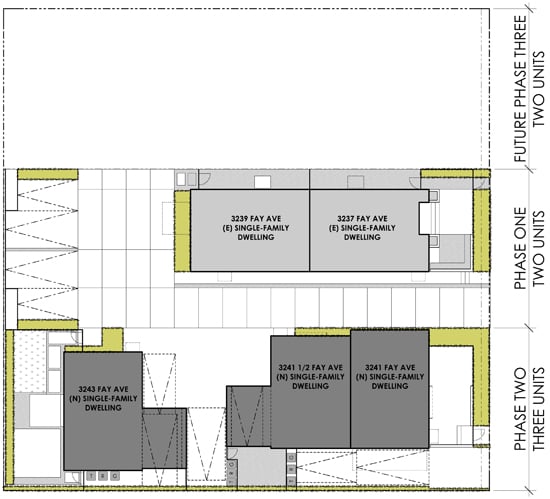
One of the best things about a phased development is that we were able to analyze and learn from round one (Fay 2X Homes) and incorporate the new knowledge into phase two. Outside of internally looking at the project through a critical eye, we also received feedback from potential renters of the first phase. The Developer and Modative both talked openly with prospective tenants about what they liked and, more importantly, would like to see improved. The responses were overwhelmingly positive, but as problem solvers, we focused on the areas needing improvement. Slightly larger bedrooms, increased storage, more yard space, and a master suite topped the list of most-desired improvements.
For us, the project working in a spreadsheet is just as important as it working in architectural plans. Phase two wasn’t going to happen if it didn’t make financial sense.
To keep costs down, we knew that we only wanted to add square footage where we needed it. Most of the spacial concerns were in the private rooms, so we knew that the additional area should be on the second floor. We accomplished this by cantilevering above (front unit) and bridging across (rear units) the carports. This move shifted the spacial balance, which was essentially 50/50 public/private in phase one, to lean towards the private space. We offset this shift by connecting the ground level living areas to large (by urban standards), usable outdoor spaces, creating a nice indoor/outdoor flow.
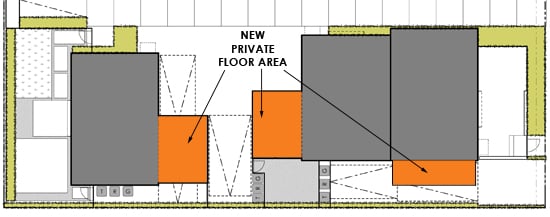
Upgrading one of the bedrooms to a master suite was another high priority item. This meant a larger bedroom area, an upgraded bathroom and a walk-in closet. At the minimum, we wanted the upgraded bathroom to have a dual sink, but we were also able to fit a larger shower and a linen closet. We also placed the wet walls back-to-back, a move that will make the plumbing subcontractor very happy.
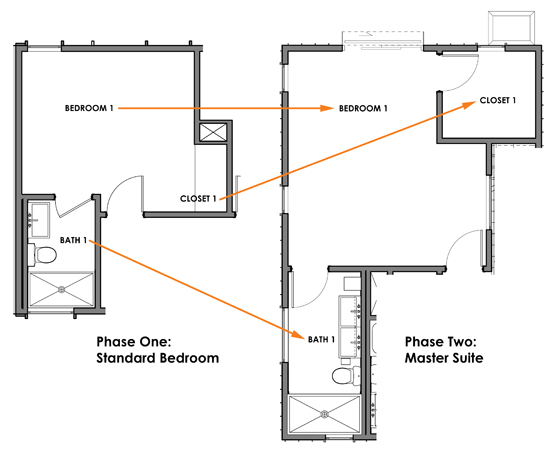
So, after adding all this area to the bedroom level, we crunched the numbers and found that the master bedrooms are 32% larger and the secondary bedrooms are 11% larger in phase two than phase one. While the walk-in closet naturally increased the master storage, we also grew the storage in the second bedroom by over 50%.
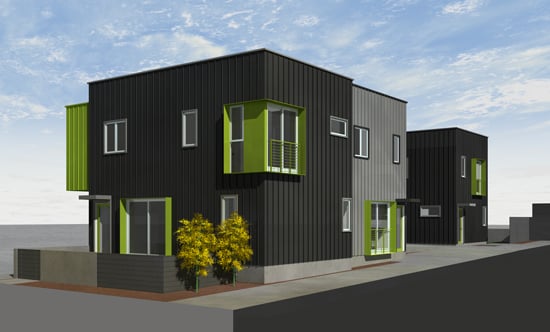
We kept the elements people liked from phase one: simple forms, interesting facade treatments and a cost-effective building design.
Phase two has three units and three door and window types, thus earning it the nickname 3X Homes, which is a spin-off of the 2X Homes concept of phase one. Construction on this phase will start in the fall of 2012 with construction completion scheduled for spring 2013.
Post by Michael Scott. Contributors to this post include Krystal Návar, Derek Leavitt and Christian Návar.
Tags: Los Angeles, los angeles architects, modern architecture firm, Small Lot Subdivision, small homes, Small House, Development, Fay Ave Art District dwellings, affordable modern architecture
A Skinny Solution for Small House Floor Plans
Posted by Krystal Navar on Wed, May 30, 2012 @ 07:05 AM
A while back, we posted about our design process for developing master suite floor plan options for the Cullen Street Small Lot Subdivision project. We presented 6 different layout options, but there were countless variations. Usually, on a project, we decide which layout to run with based on our own design preference and direction given to us by our client.
Our 14-home Commerce Villas Small Lot Subdivision project in Tujunga, however, presented a unique set of challenges. To lay out 14 homes on the site in the most efficient manner, taking into consideration setbacks, driveway widths, vehicle backup requirements, etc., each home ended up being a mere 15’-0” wide, measuring from the exterior face of the north wall to the exterior face of the south wall.
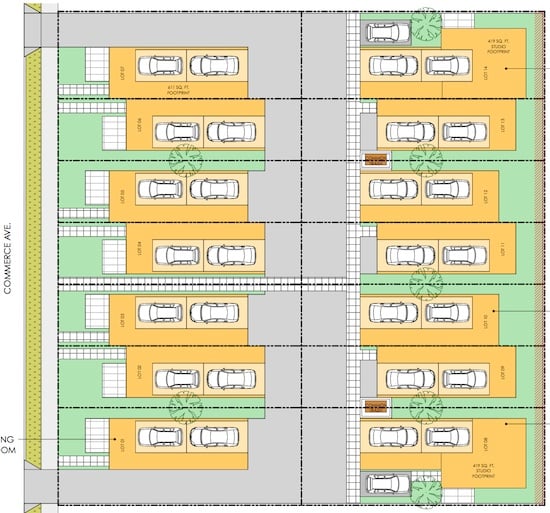
Site Plan of Commerce Villas project
The Cullen Street building footprints are generally square, whereas the Commerce Villas building footprints are long and skinny. So, unlike the Cullen homes, where there were many variations of floor plan layouts, the narrowness of the Commerce Villas homes limited our options. There are only so many ways to lay out a home like this, fitting in the programatic requirements given to us by the client: 2 bedrooms, 2 baths, outdoor decks/patios, and 2 covered parking spaces in 1200-1500 square feet.
First of all, the narrowness of the homes necessitates that the parking be tandem. (We can discuss the pros and cons of tandem parking all day long, but we’ll leave that to another blog post.) Also, we decided early on through discussions with the client that the living level (kitchen, dining room, living room, and powder room) would be located on the second level and the bedrooms and laundry located on the third level due to the age of the anticipated potential buyer. We expected this buyer would not want to haul their groceries up two flights of stairs. (Many times, though, on other projects, we will locate the living spaces on the upper level when the project is appealing to a younger demographic and the views from the upper level warrant being appreciated during daylight hours and not while you’re sleeping in bed.)
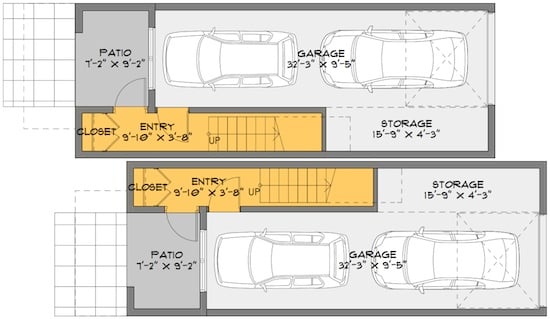
Early first floor plan
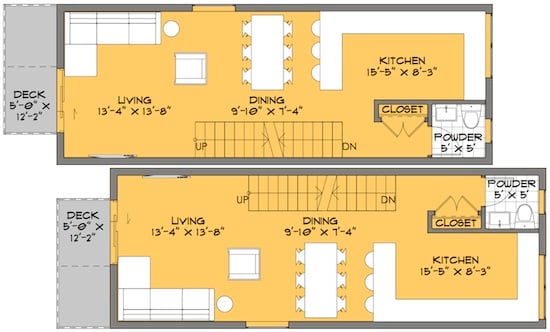
Early second floor plan
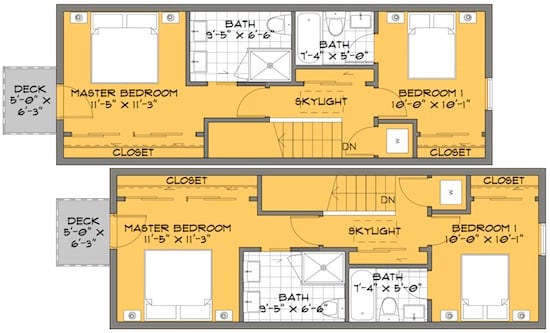
Early third floor plan
So, keeping these constraints in mind, after locating the parking in the footprint, there is only one space to locate the stair without having the stair separate the living spaces from the deck or yard space. Once the stair is located, the big decision is on which side of the home (east or west) to locate the kitchen or the living room. Should the kitchen have direct access to the deck (so the user doesn’t have very far to travel when bbq-ing) or should the living room? The client chose Option 2.
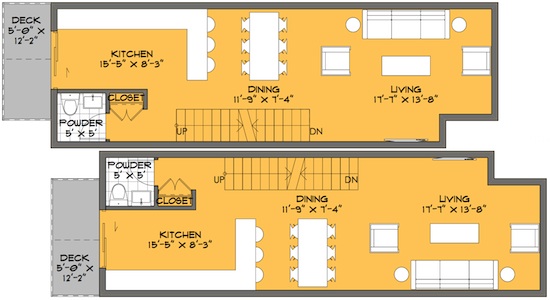
Option 1 showing the kitchen next to the deck. (See Option 2 above with living next to the deck.)
We also developed a second option for the bedroom level with a walk-in laundry room instead of a stacking washer/dryer in a laundry closet. Ultimately, we decided to locate the bathrooms next to one another so they could share a plumbing wall. The client also decided that a walk-in laundry room was not a priority.
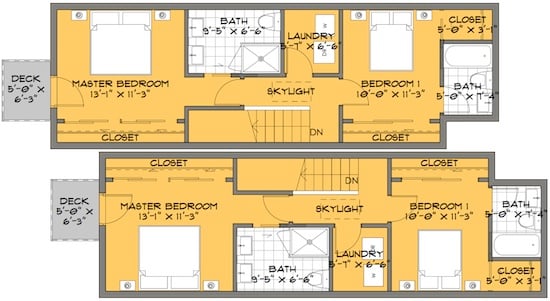
Option 2 showing the kitchen next to the deck. (See Option 1 above.)
As we spent more time looking at the buildings three-dimensionally in our computer model, we tried ways to spice things up. We couldn’t do anything too crazy as keeping the cost of construction low was a priority. In an attempt to make the 6’-0” spaces between the buildings a more interesting space to occupy, we angled the exterior walls facing those gaps. However, because the walls could not be angled out to make the buildings greater than 15’-0” wide, the walls had to be angled in, making the already limited interior spaces smaller. When your home is only 15’-0” wide, every inch counts. Ultimately, we decided that the angled walls were not angled enough to be worth the effort (or implied cost), so we straightened them back out.
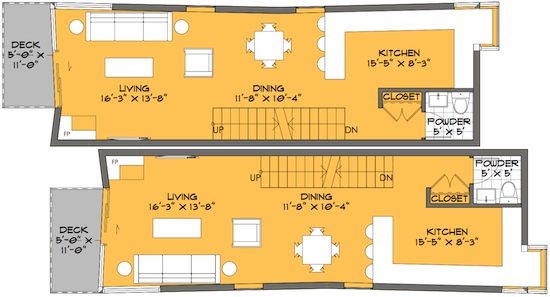
Second level floor plan showing angled walls
In the latest layouts, we did keep the angled walls on the front of the units in order to give the elevation a bit of shadow-play and interest. As you may have already noticed, we also staggered the building pairs. We did not want to present the street or the interior driveway with a flush wall of 3-story homes. Staggering the homes gives these elevations a bit of relief and creates a more interesting pedestrian experience.
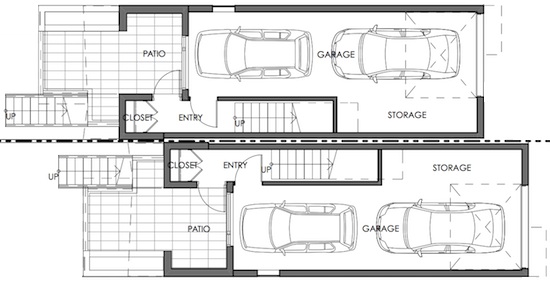
Latest first floor plan
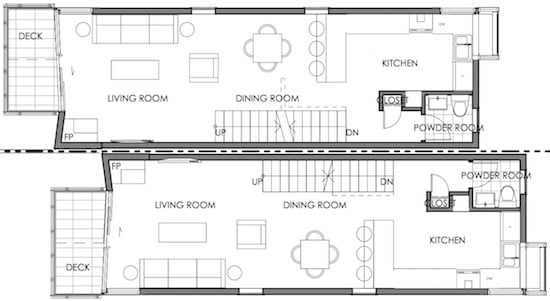
Latest second floor plan
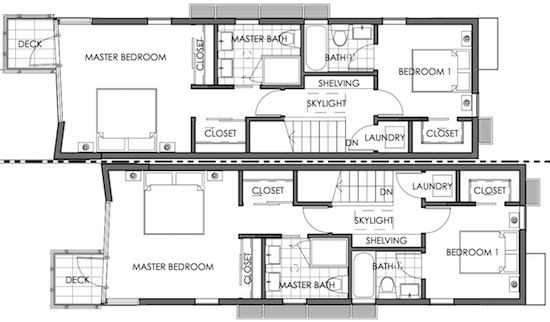
Latest third floor plan
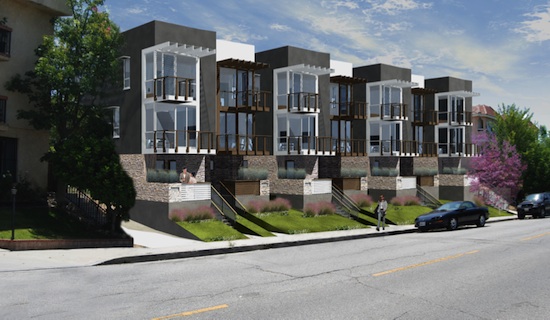
Project rendering
Post by Krystal Návar. Contributors to this post include Christian Návar, Derek Leavitt and Michael Scott .
Tags: los angeles architects, home size, Floor Plans, Residential, Small Lot Subdivision, small homes, Small House, affordable modern architecture
A Modern Architecture Firm's Approach to Organizing Marketing Leads
Posted by Derek Leavitt on Wed, May 2, 2012 @ 06:05 AM
At the tail end of 2010, we realized that the worst of the recession was over for us. Things were getting better. New marketing leads were coming in and we needed to better manage them if we were to take full advantage of this potential increase in business.
As with most small architecture firms, the three principals split up the core roles of running the company. As a principal, one of my roles is marketing manager. So, as 2011 approached, I worked with Christian and Michael to come up with a system for managing leads coming into the office.
When it comes to lead generation, our office is a bit different than most architects in that about 90% of our leads come through our website. So, unlike many older offices that get high probability referral leads, we have to sort through significant noise in our web leads to find the valuable ones. This only increases our need to be more organized.
We began this process by generating two simple diagrams. The first diagram is a simple breakdown of how Modative acquires projects.
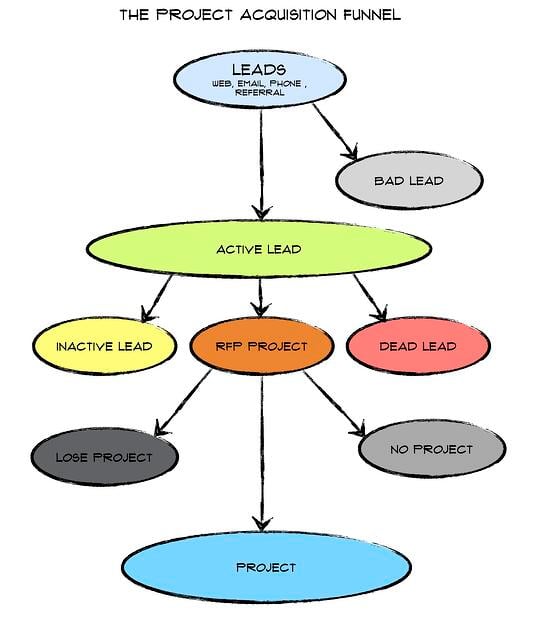
The basic idea in this diagram is that you get leads and filter them down to determine which ones become RFP (Request for Proposal) projects (a small win) and then, after proposals and contracts, which ones become real projects (a big win).
The second diagram describes our process of organizing and managing active leads.
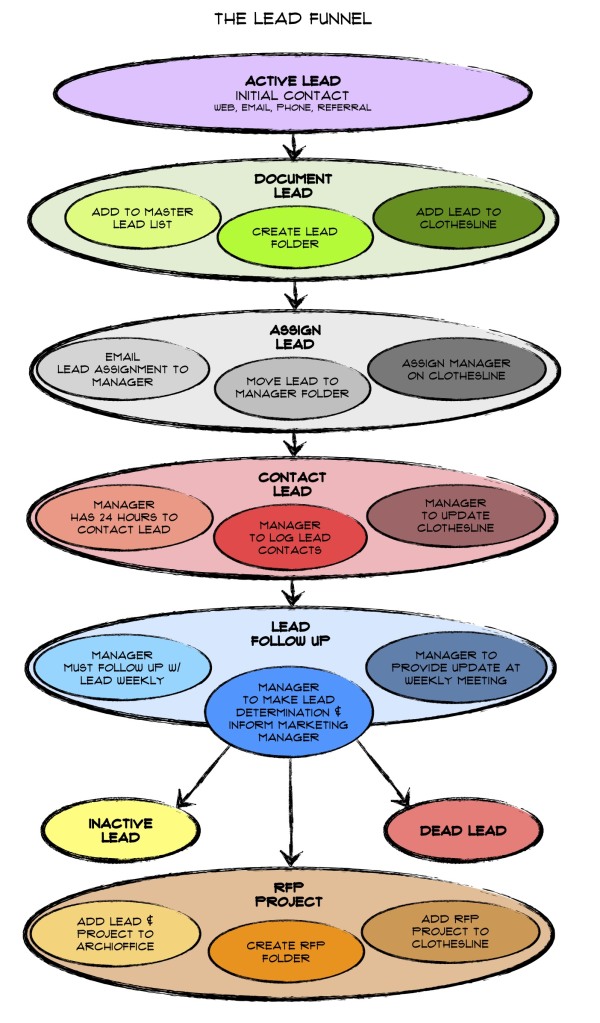
Let's take a closer look at what each step entails.
Document and Assign Lead
1. Add Lead to Master List - This is a simple Excel spreadsheet (we use Numbers, a Mac program) that tracks the basics and is used to give incoming leads a number. Lead numbers begin with an "L" for "Lead" and the last two digits of the year, followed by three digits - L11-001. Here's a sample of the Master Lead List.
| Lead # | Lead Name | Start Date | First Contact Date | Assigned To | Project Type | Lead Type | Notes |
| L11-044 | John Doe | 06.12.11 | 06.13.11 | CDN | SFR | Phone | W. LA Home |
| L11-045 | Jane Smith | 06.18.11 | 06.19.11 | MDS | SLS | Web Form | Venice Beach |
2. Create Lead Folder - Active leads are assigned to managers and the following folder structure is copied into the lead managers folder (on the server) and given the appropriate name - "L11-044 John Doe 06.12.11".

In the "Lead Log and Checklist" folder, there is a word processor file that is filled out with the same info from the Master Lead List and most often, a copy of the the web form data. Below that is a log for the lead manager to keep track of all correspondence with the lead.
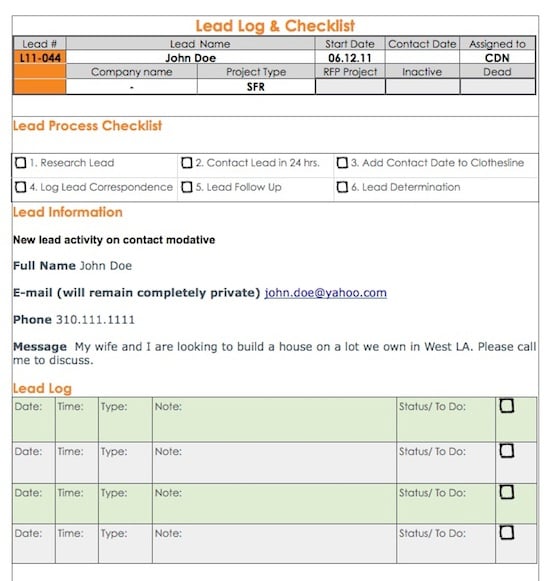
3. Add Lead to Clothesline - If you missed last year's post on "The Clothesline", check it out to see one of the ways we stay organized. Similar to the Master Lead List, the lead info is added via permanent marker (old school, I know) to the Clothesline in the office for everyone to see.
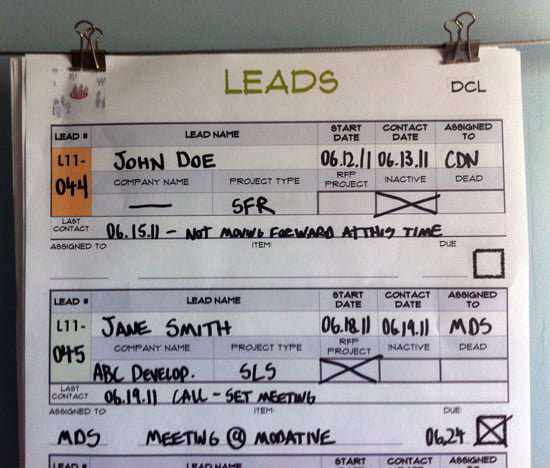
As marketing manger, this provides me with a quick visual on how leads are progressing.
4. Email Lead Assignment to Manger - After the lead has been documented and assigned, we send out a simple email to the lead manager, letting them know that they now have an active lead.
Contact Lead & Follow-Up
1. Initial Lead Contact - It is the lead manager's job to contact the lead within 24 hours and log this contact in both the Lead Log and Clothesline. Most lead managers print out the Lead Log and hand write in the information while on the phone.
2. Lead Follow-up and Determination - After contacting the lead, it is the lead manager's job to determine whether the lead is "Dead", "Inactive" or has the potential to become an "RFP Project". If the lead has potential, the next step is often an in-person meeting. If that goes well, the project graduates to become an "RFP Project" when the potential client asks for a proposal.
3. Weekly Updates - At our regular Monday morning meetings, we review all active leads and managers give a quick update.
Does This Lead Management Process Work?
I'm sure for many, this process seems like overkill. There are several steps and many of them accomplish similar things. But for us, this system has created a series of checks and balances that has worked well versus the alternative of Post-it notes and haphazard internal conversations. No matter how you look at it, without proper lead management, we would be lucky to get any new projects. Besides, any aspect of running our office where we can be more efficient, only leaves us more time to better serve our existing clients.
What systems do you have in place at your office for lead management?
Post by Derek Leavitt. Contributors to this post include Christian Návar, Krystal Návar, and Michael Scott.
Tags: Organization, Architectual Practice, modern architecture firm, architecture resorces, Starting an architecture firm, Marketing
Small Lot Subdivision Branching Out of Los Angeles?
Posted by Christian Navar on Thu, Apr 26, 2012 @ 06:04 AM
Derek and I recently spoke at a mobile workshop on LA's Small Lot Ordinance at the American Planning Association's (APA) National Conference in Los Angeles. At the conclusion of the workshop, we were asked, by an attendee of the workshop, a question about affordability (we like to use “attainability” because when people hear “affordability” they tend to only think of low-income housing). The attendee who asked the question turned out to be a City Council member from the capital city of a state, outside of California, with a population of over a million people (for the sake of privacy and the future of this person’s political career, the person and the city will remain nameless in this blog entry... for now).
At the conclusion of a very brief back-and-forth dialogue with the councilman, I offered an open invitation to discuss the issue in greater depth. I suggested modative help him figure out if the economics within his district warranted what we feel is one of the greatest city ordinances in the United States. He gave me his card and asked that I get in contact with him.
In today’s blog post, I would like to share with everyone my initial e-mail to the Council District representative in an attempt to follow up and get this innovative planning method and practice into another great city:
Hello [City Council member],
I hope the rest of your stay in Los Angeles and your travel back to [your city] was great! It was nice briefly meeting you on the APA Small Lot Subdivision tour. Thank you for joining us and I hope you enjoyed our brief presentation regarding a few of our Small Lot Subdivision projects.
Your question regarding "affordability" was a fantastic one and I would love the opportunity to discuss it further with you. Here, in our office, we utilize Small Lot Subdivision as a means to practice architecture and construction. However, our true passion lies in better understanding the economics involved in the ordinance's implementation.
Our goal is to develop these projects and provide an attainable housing alternative that will help stop the mass departure of our own friends from Los Angeles. All of us at Modative attended the University of Southern California. Our friends and colleagues from USC are now Architects, Engineers, Lawyers, Doctors, Professors, etc. Unfortunately, due to the high cost of housing in Los Angeles, homeownership is no longer attainable, even for those who practice in top-tier professional fields. Many of our closest friends can no longer afford to live in the city and state they grew up in. We are tired of attending going away parties for friends and family moving to more affordable cities like Portland, Austin, Denver, and Phoenix. We see the potential in the Small Lot Subdivision Ordinance to solve this problem.
Our involvement in the Small Lot Subdivision Ordinance has been a great experience thus far. We have become experts in this ordinance and have ideas about how it could be modified to better achieve what it was originally intended to do. We are still firm believers in this housing alternative and think that, with a few small changes or by thinking a bit out of the box, we will soon be able to develop a housing stock that keeps L.A.'s professional class from migrating elsewhere.
From your website, I gather your city is experiencing some growth and you are very interested in future planning while providing opportunity that is mutually beneficial to your constituents and those looking for new possibilities. We believe [your city] would be a great place to adopt a similar ordinance and provide a better, attainable housing alternative. After an initial quick glance at your Planning and Zoning website, it looks like your [medium density residential 1] through [medium density residential 2] zones would be ideal zones in which to implement a Small Lot Subdivision Ordinance.
Reviewing some aerial maps, I found a project at the termination of [This] St. and [That] St. that looks to be an approximately 15-unit residential project with "adjoining walls". This may have been a perfect opportunity to provide a "fee-simple" alternative to new home ownership (see below).
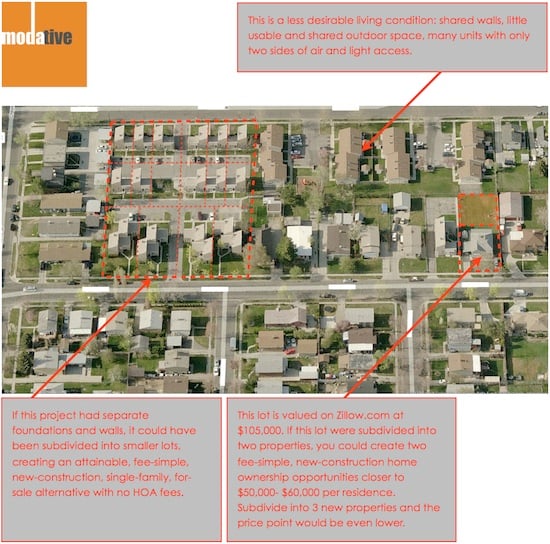
When are you available to talk more about the economics of this type of project? Please let me know when you are free to schedule a follow-up phone call. I look forward to talking to you soon.
Here is a link to a page on our website where you can access the guide we developed regarding developing small lot subdivision projects in Los Angeles.
Small Lot Subdivision Guide - Free Download
Here is a link to a page on our website where you can access useful documents from the City of Los Angeles pertaining to the Small Lot Subdivision Ordinance.
Free Download of Small Lot Subdivision Information
Thanks,
-Christian
On a side note, if you are a City Council member or city planner, have come across today’s blog post, and are interested in discussing or adopting a similar ordinance in your community, feel free to contact modative. We would be happy to help you draft a similar innovative planning policy or conduct a Small Lot Subdivision housing needs assessment for your city. It is possible to provide a creative “attainable” housing solution that will help create better living environments for you and your community.
For any developers, architects, or concerned citizens out there who feel there is inadequate attainable housing in your city, feel free to contact us as well. Or, use my letter above as inspiration to contact your own City Council or planning representative.
We will keep you updated on the Council District representative’s response!
Post by Christian Návar. Contributors to this post include Krystal Návar, Derek Leavitt and Michael Scott.
Tags: Los Angeles, los angeles architects, Property, Residential, Small Lot Subdivision, Development, Subdivisions, Housing, Planning
7 Tips for Starting an Architecture Firm - Tip 07: Plan It Out
Posted by Derek Leavitt on Tue, Mar 13, 2012 @ 09:03 AM
This post is part of the How to Start an Architecture Firm series.
In February 2006, Christian, Michael and I went to work on forming our own architecture firm. The following is tip number seven of seven in our start-up strategy.
Side Note: After an almost two year break between Tip 06 and Tip 07, I thought it was about time to wrap up this series. We've had an interesting two years, surviving the recession and emerging as a viable and busy architecture firm. Enjoy!
Tip 07: Plan It Out

When architects dream of running their own firms, they often flash right to the fun stuff:
What types of buildings will we design?
What will our design philosophy be?
While these are important questions, it's important to design your business with equal thought. When I think back to Modative's founding, I don't think as much about that actual first day of being out on our own as much as the six months leading up to the launch. During this time, we met once a week to hash things out while still working our day jobs for other architecture firms. Because the three of us lived in the three corners of Los Angeles, we would either meet online (thanks ichat) or we would drive to USC at night (where we all had gone to school) and sneak into a classroom at the VKC building.

The VKC @ USC. Photo taken by Bobak Ha'Eri, on May 27, 2007
It was important to determine certain things before we all quit our day jobs. We didn't meet to create some exhaustive business plan that no one would read, but to determine general goals and strategies for the company. If you don't establish a grander vision from the start, two things are likely to happen:
1. You'll get too busy doing actual work (projects) and your firm will operate without a vision. This is like designing a project without clear goals or concepts: it can be done, but it doesn't lead to a great product.
2. You'll have no way to measure at whether you've been successful in achieving your goals.
One of the ways we got organized was to develop a strategic plan. The first step in that process was a SWOT analysis. SWOT is an acronym for Strengths, Weaknesses, Opportunities, and Threats. Here was our original SWOT analysis from 2006:
SWOT Analysis
Internal |
External |
Strengths |
Opportunities |
|
1.creativity 2. team approach 3. design ability 4. “technology” 5. organizational ability 6. diversity 7. presentation 8. leadership 9. network
|
1. former employers 2. large/ diverse residential pool 3. location - los angeles 4. network-friends and family 5. real estate agents, contractors 6. development projects 7. building possibly 8. “non-architecture” projects 9. diversity of los angeles 10. money in los angeles 11. music, movie, sports industry 12. “housing buble” burst 13. having lower fees |
Weakness |
Threat |
|
1.not having “own” portfolio 2. no professional license 3. weak “field” const. experience 4. no infrastructure (equipment) 5. other than type “V” construction 6. staff quantity 7. experience/ age 8. inefficient staff-to-principle ratio 9. publicity 10. financial resources 11. credit worthiness |
1.other capable firms 2. “housing bubble” burst 3. # of firms in los angeles 4. general misperception of no need for architect 5. major markets outside of los angeles 6. having lower fees 7. lack of credit and cash
|
Looking back after six years of being in business, many of these initial SWOT assumptions were correct. Over the years we've been able to take advantage of our strengths and opportunities, while reducing the weaknesses and threats. In the end, developing a strategic plan was easy -the final document was only five pages long.
Choose Your Partners Carefully
If you have business partners, this planning process is even more critical to determine if you and your partners share the same values. We all knew each other since our early days at USC, but just as important, we had overlapping work experience prior to starting Modative, meaning that we had worked together professionally prior to starting our firm. Here's a diagram we posted on our website back in 2006 showing our experience overlap.

Now that we've shared Modative's founding story, it's time to begin your story.
Use the navigation below to get caught up on all of our 7 Tips for Starting an Architecture Firm.
 |
7 Tips for Starting an Architecture Firm |
 |
00 BootstrappingNot a tip, but a critical theme in our start-up adventure. posted 12.03.09 |
 |
01 Be Cheapposted 12.08.09 |
 |
02 DIY (Do It Yourself)posted 12.18.09 |
 |
03 Get Adviceposted 12.22.09 |
 |
04 Learn from the Badposted 01.22.10 |
 |
05 Start and Stay Smallposted 03.03.10 |
 |
06 Stay Flexibleposted 04.05.10 |
 |
07 Plan It Outposted 03.13.12 |
The bad news is that this is the last of the 7 Tips to Starting an Architecture Firm. The good news is that we're learning and posting new tips all the time.
Stay up-to-date by subscribing to this blog by adding your email to the subscribe form. Or, if you're a technocrat, you can grab our rss feed.
Tags: Los Angeles, los angeles architects, Inspiration, Communication, Architectual Practice, architecture resorces, Starting an architecture firm
Fay 2x Homes - Future Small Lot Subdivision Construction Complete!
Posted by Krystal Navar on Wed, Feb 22, 2012 @ 06:02 AM
In November 2010, we posted about our cost-effective solution to reviving a project that had completely stalled due to the housing bust (see: Modative Architecture Provides Stimulus Package.) Well, since this last post, our sister company, Modative Build, has completed construction of Phase One of this new Fay Ave. project!
To recap, the “2x” concept came out of finding a simple, creative, cost-effective solution to this goal: to re-imagine a pre-housing-bust development for a much different market. Fay 2x Homes is the reincarnation of the Fay Ave Art District Dwellings, a seven-home Small Lot Subdivision project, which was designed before the real estate market crashed. Our challenge, as architects, was to reinvent this project for a changed economy.
The seven-home project would ultimately utilize three adjacent lots; however, the center lot was sitting vacant, and, as such, was not providing any income for the owner while the development stalled. Our client asked us to propose a simple, cost-effective design that would add immediate value to this vacant lot and start generating rental income. We decided to drastically simplify the design of the homes and to phase construction in a way that made the most financial sense for our client. The two homes pictured make up Phase One of a four-phase project.
While the modern design of the project was inspired and influenced by its’ location near the Culver City Arts District, the straightforward design is a direct result of providing a cost-conscious solution for our client. We decided to limit certain building components to only two variations as a way to minimize the overall project cost. This self-imposed limitation is evident throughout the design of the homes: phase one consists of two homes, each utilizing just two exterior materials, two interior materials, two colors, two window sizes, and two door sizes. Further emphasizing the “2x” concept, each home contains two bedrooms and two and a half bathrooms on two floors, for a combined total of 2,000 square feet. These smaller, more affordable homes are being rented as apartments until all four phases are complete and the properties are ultimately subdivided into seven lots/homes per the Los Angeles Small Lot Subdivision Ordinance.
As a burgeoning design/build firm, we were also able to act as the General Contractor on this project. This helped to keep the cost of construction down for our client by drastically minimizing the cost of change orders that are typically a part of a traditional architect/contractor construction project relationship.
Phase One of this project was completed December 2011 and is now fully occupied.
Here are some photos of the first completed phase of the Fay 2x Homes. Enjoy!
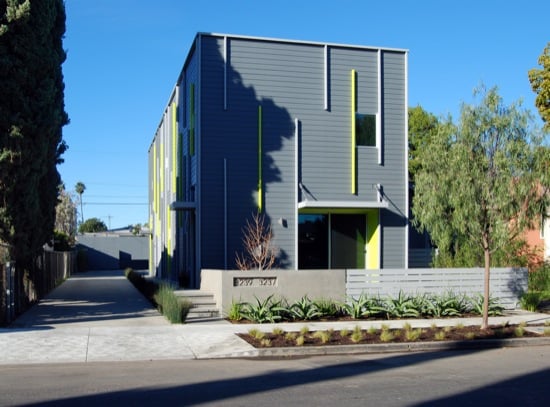
The simplicity of the Fay 2x Homes allowed the property owner to start earning rental income ASAP.

The wood 2x vertical fins, while hiding the connection details of the cement board siding, also create a graphic pattern on each building face. The patterns are dynamic and change with the time of day, especially on the south walls.
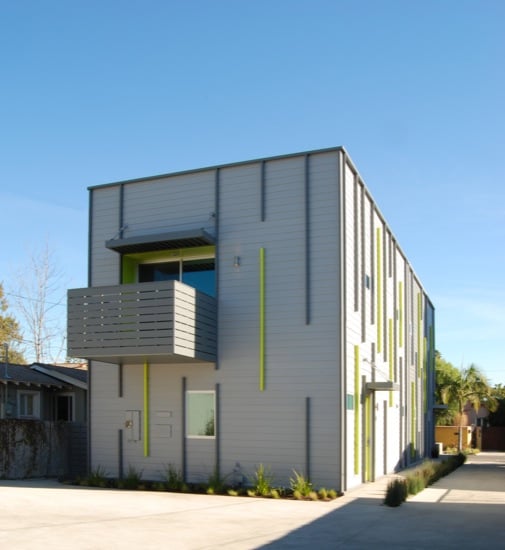
A view of the back of the property. Check out all that vehicle back-up space required by the city! It's a crazy amount of space dedicated to the car, but I could throw a mean bbq shindig back there, so it's not totally wasted space.
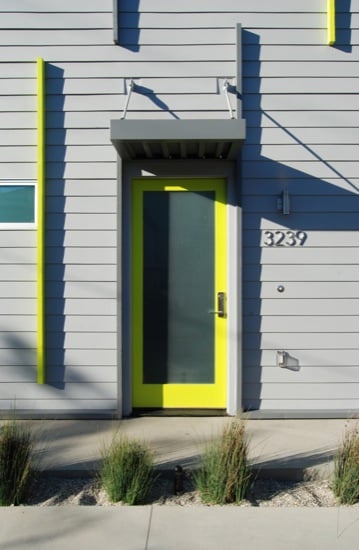
The home entrances are punctuated by bright green doors.
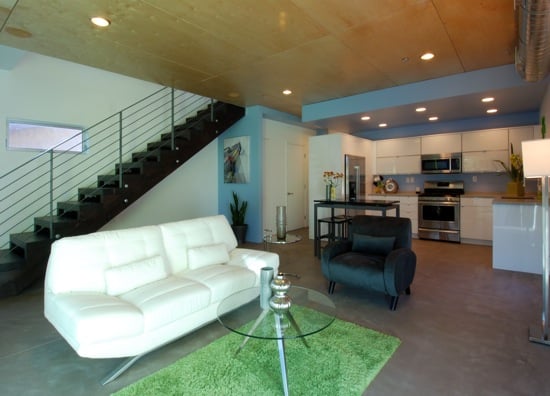
The concrete floor, plywood ceiling, and IKEA kitchen were all cost-conscious moves to keep the homes relevant in today's market.
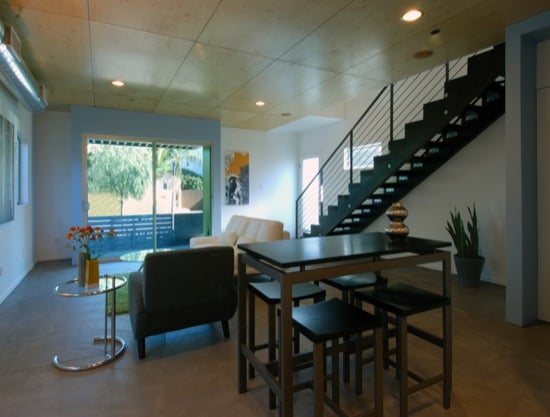
The front home's living area opens out onto a ground-level patio that engages Fay Ave.
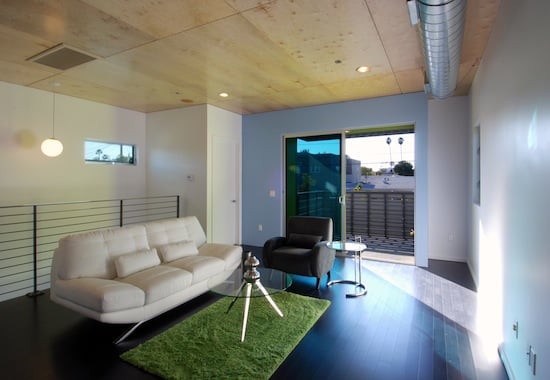
The back home's living area is on the upper level, taking advantage of views toward the Baldwin Hills and the Helm's Bakery sign.
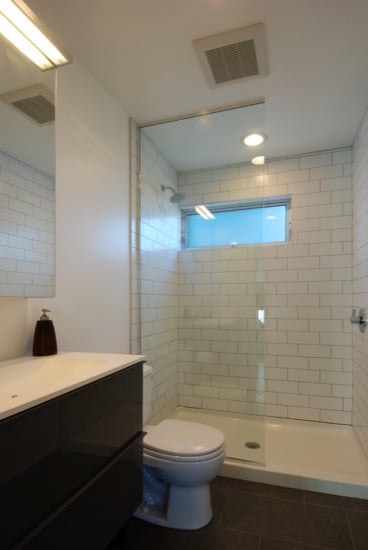
The bathroom finishes land just below custom-home level, but well above apartment-grade on the finish quality meter.
Post by Krystal Návar. Contributors to this post include Christian Návar, Derek Leavitt and Michael Scott .
Tags: Los Angeles, los angeles architects, culver city, construction, Small Lot Subdivision, small homes, Small House, Fay Ave Art District dwellings, contractor
Modative Architecture Impacts Culver City Arts District
Posted by Krystal Navar on Thu, Oct 20, 2011 @ 06:10 AM
In our last post on the Roberts Avenue Residence, we took you through the schematic design process -- at least how our office goes about it. If you remember, the client picked Scheme A, which consisted of a series of shifting bedroom boxes on the ground floor, visibly and audibly sheltered from the neighboring park. The living level and guest bedroom were located on the upper floor, taking full advantage of the views over the park and beyond to Baldwin Hills.

To refresh your memory, here’s an image of Scheme A during Schematic Design.
You will see that the driving concept remains in the final design: quiet, spa-like spaces on the ground floor and open, airy spaces on the second floor. Although, there have been some adjustments. For instance, the guest bedroom and the master bedroom swapped locations. The client felt that the master bedroom, with it’s own private balcony on the second floor, would better benefit from the views. The bedroom volumes also shifted to alleviate the need for excessive steel structure to support unnecessary cantilevers.
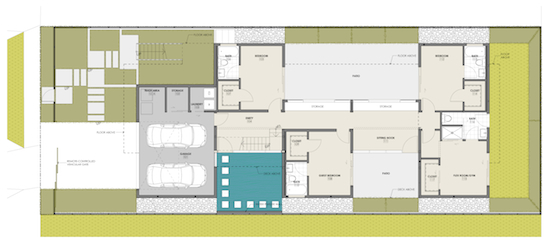
First Floor Plan
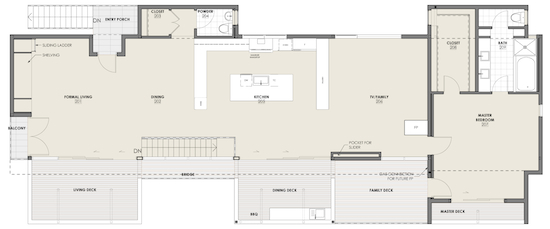
Second Floor Plan
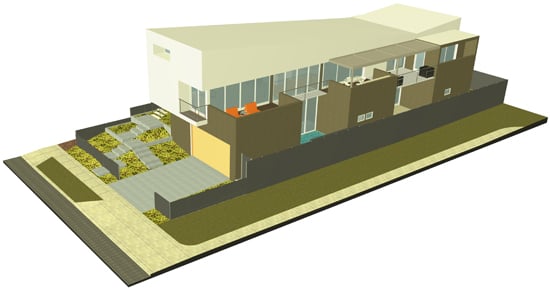
Rendering
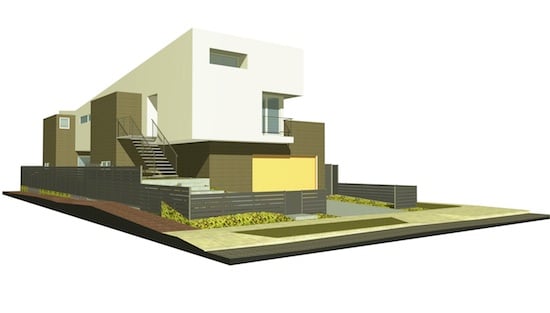
Rendering
We have submitted for permits and are now waiting to receive comments back from the City. Once that happens, and we make the necessary corrections, bidding begins. Construction is expected to start by January 2012. Look for more updates to come with photos of the construction process.
But, before we part, this is the perfect time to introduce our next project. As many of you know, a happy client on one project can lead to a happy repeat client on a new project. Our client on the Roberts Avenue Residence recently purchased a property on Fay Avenue -- a mere 0.2 miles from our office -- on which he wants to build 4 small-lot homes. This property is in Los Angeles, so it can take advantage of Los Angeles’s Small Lot Subdivision Ordinance. I know! What a great fit for Modative! (If you’re not familiar with the Small Lot Subdivision Ordinance in Los Angeles, click on the link and read up! It’s pretty cool (and, really, my only hope for brand-new home ownership in LA.)
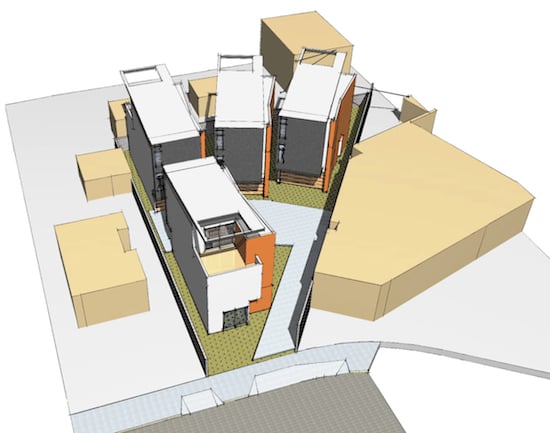
Fay Triangle Site Plan
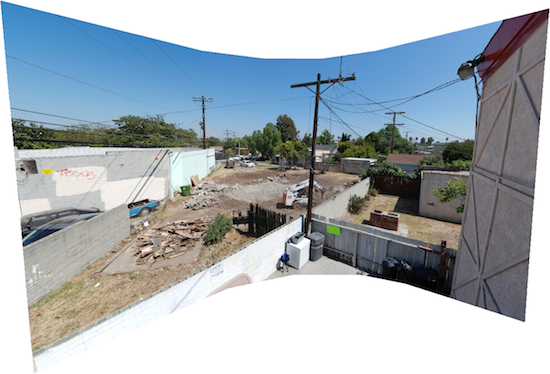
Photo of Fay Triangle site taken from adjacent building
We are excited about this new project for two main reasons. First, we have been eyeing this triangle-shaped property for the entire five years our office has been in the area, long before it was even up for sale. (I was hoping it would somehow be left to me in someone’s will, but that would have been highly unlikely.) Second, this property is only four properties down from our Fay 2x Homes project. To have so many projects located within a mile radius of one another (in our own neighborhood, nonetheless!) has been really special. We have the rare opportunity to inject this area with thoughtful, modern design. (Check out our other projects in the area: Cullen St. Homes, Fay 2x Homes, Roberts Avenue Residence, Venice Urban Dwellings.) Stay tuned for updates on this new project we’re calling Fay Triangle.
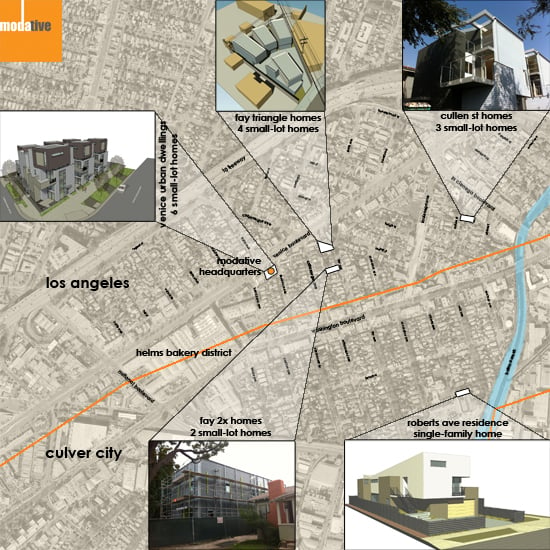
Map of Modative projects in our neighborhood
Post by Krystal Návar. Contributors to this post include Christian Návar, Derek Leavitt and Michael Scott .
Tags: Los Angeles, los angeles architects, Modern Design, Architecture portfolio, real estate, Architectual Practice, culver city, Residential, Small Lot Subdivision, Housing
A Los Angeles Architecture Firm's Design Process
Posted by Krystal Navar on Thu, Jun 23, 2011 @ 06:06 AM
Different architecture firms approach the design process in different ways. Here at Modative, we are beyond thorough. Recently, we began working on a new single-family residence in Culver City, CA, a stone's throw from our office. We thought it would be fun to take you through Modative's design process, using this new project, Roberts Avenue, as the example. So, here it goes.
Before pen ever meets paper, we undergo a thorough site analysis. Many firms skip right on by this, what we feel to be, the crucial first step of the design process. We believe that the site should influence the design. Our site analysis covers topics such as physical site conditions, prevailing winds, street grids, circulation to and from the site, views in and views out, noise, and neighborhood character.

3 diagrams showing views, noise, and pedestrian access

View north on Roberts Avenue

View from what will be the second floor of the new house

A few interesting modern homes in the neighborhood
We keep the client involved in every step of the process, so once we've hashed through the site analysis, we present the information we've gathered to the client. We figure that if the client is with you through these initial steps, once you get into the schematic design phase, the sketches you show him/her will not seem to have come out of nowhere. Most importantly, the decisions you are making will not seem arbitrary -- they will be rooted in your initial site and precedent studies. Both you and the client will be able to reference back to this gathered information as the design progresses.
At this point, during our first presentation to the client, we also discuss the project's program, budget, and schedule. Once we have a better understanding of these three criteria, we launch into the design of the building. On this project, our intern, Jonathan Ackerman, built a series of small massing models at 1/16"=1'0" studying possible configurations based on allowable square footage and the influences of the surroundings. This is where the site considerations previously mentioned come into play. Knowing that this site is located next to a public park and across the street from an elementary school informs how the masses are organized.
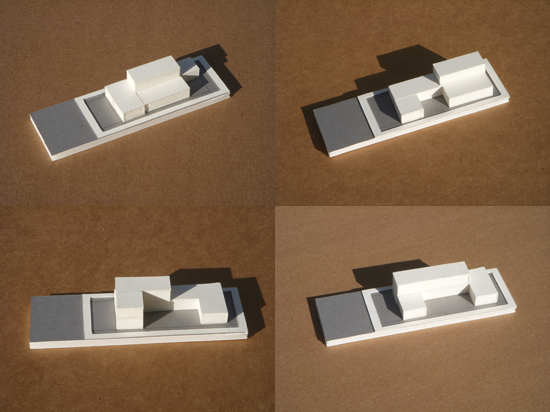
4 massing models by Jonathan Ackerman
The next step is to sit down with everyone in the office (all 5 of us at the time) and brainstorm. We give the same presentation to the office that we gave to the client and go through each of the massing models. Then the trace paper is rolled out, everyone gets quiet, and starts feverishly sketching. This is the fun part. (I like to stop sketching 5 minutes into it, take a peak at everyone else's sketches, and let my thoughts be catapulted in a completely new direction.) This is the time to not hold back. Every idea is possible.
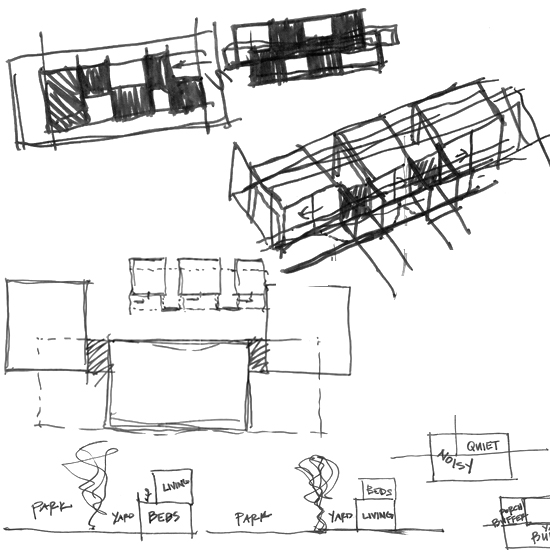
Sketches of what will become Scheme A
When everyone has exhausted their supply of trace, each person explains their thoughts to the group. (It's amazing how, after seeing the same site analysis presentation, everyone's schemes have common threads. It shows you that the site really does drive the design.) Once we've thoroughly dissected each person's concepts, we settle on 2-3 schemes that the project designer will further develop to show the client.
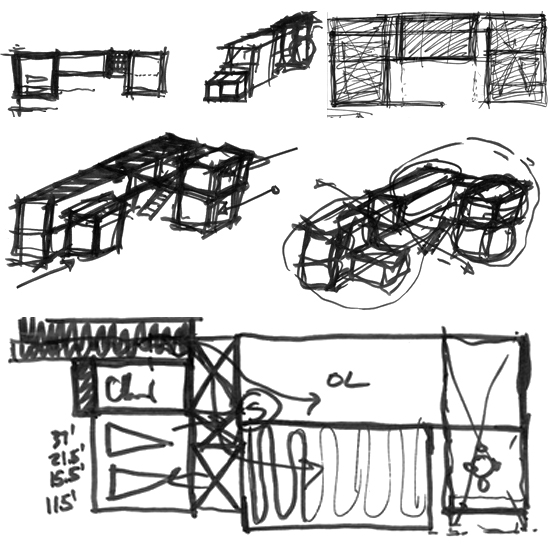
Sketches of what will become Scheme B
Before starting to develop these schemes, we research relevant precedents. Inspiration and direction both come from studying what others have done to solve problems similar to those you are facing in your design challenge.
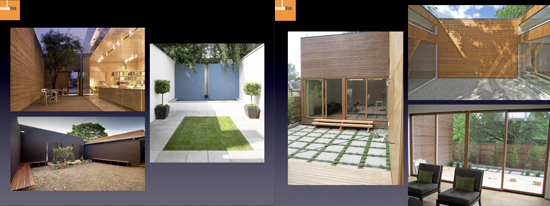
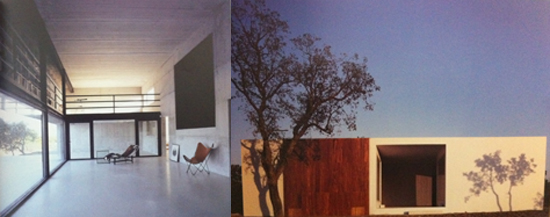
Precedent images taken from slides from our client presentation
At this point, the project designer takes everyone's sketches and began translating these sketched concepts into actual floor plans and massing models in ArchiCAD. We decided to continue to develop 2 of the schemes that came out of our in-office charrette.
After these floor plans were developed enough to talk about, we had another quick meeting with the office to get input from everyone on any minor adjustments that need to be made.

Scheme A draft renderings

Scheme B draft renderings
Maintaining this idea that the client needs to be brought along beside us every step of the process, before we even show floor plans and renderings, we show some 3D diagrams explaining the reasoning that is informing our design decisions.


Scheme A diagrams

Scheme B diagrams
At this point, all of the layouts are in ArchiCAD. However, we choose to sketch over print-outs of the layouts and show these sketches to the client instead of showing them hard-lined floor plans. Hard-lined floor plans, this early in the design process, give the impression that everything is figured out and that it's too developed to make changes. It's important, at this stage, for the client to feel that their input is welcome and that the design is a malleable thing, not a fixed thing. We also show "sketchier" renderings instead of realistic-looking renderings.
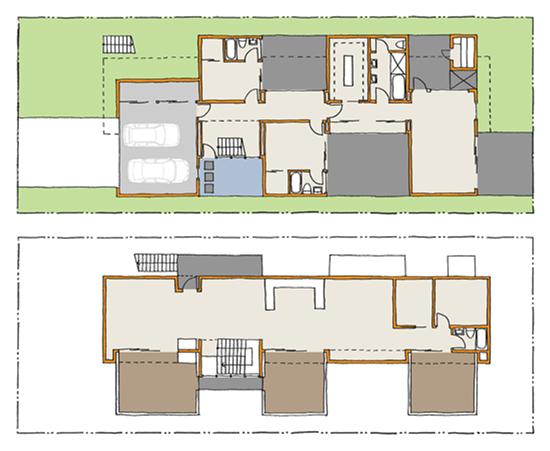

Scheme A sketchy floor plans and renderings
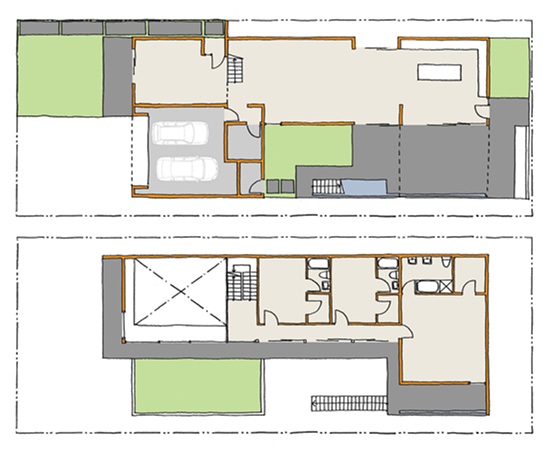

Scheme B sketchy floor plans and renderings
At the end of our presentation of these 2 schemes to the client, the client picks 1 scheme to run with. (They picked Scheme 1. They like -- and so do we -- how the living is on the upper floor to take advantage of the views.) Once 1 scheme is chosen, we have finished the Schematic Design phase and move into the Design Development phase where the floor plans are tightened up, the look of the building is massaged, and materiality that supports the concept is explored. The Schematic Design phase, when all of the above steps are taken, serves to lay the framework for all of the decisions made in the Design Development phase. This is critical in the development of a thoughtful, relevant design.
Post by Krystal Návar. Contributors to this post include Christian Návar, Derek Leavitt and Michael Scott .
Tags: los angeles architects, Modern Design, Architecture portfolio, Inspiration, Architectual Practice, Floor Plans, Residential




